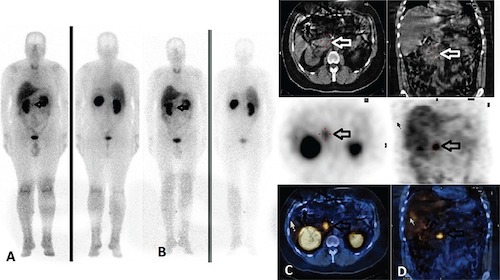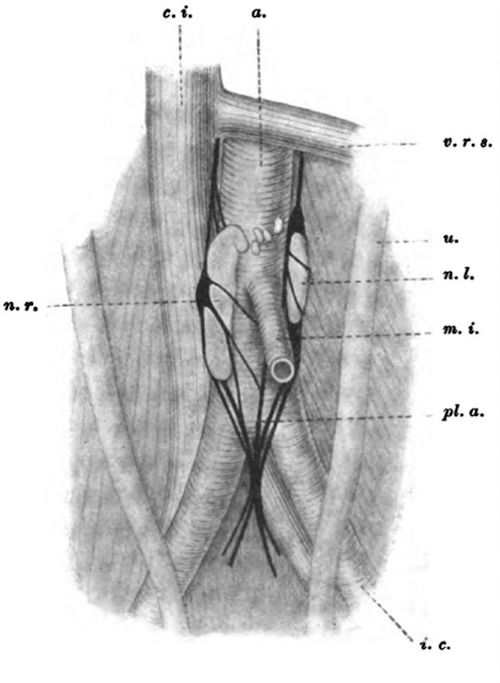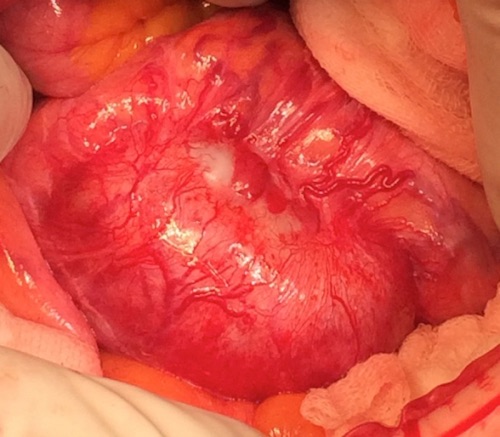Endocrine: Pheochromocytoma
Pheochromocytoma
Definition
- Pheochromocytoma: Neural Crest/Chromaffin Cell Tumor of the Adrenal Medulla
- Pheochromocytoma of the Adrenal Medulla is More Common (85%) than Extraadrenal Sites
- Paraganglioma: Extra-Adrenal Neural Crest/Chromaffin Cell Tumor
- Most Common Extraadrenal Site: Organ of Zuckerkandl
- Extra-Adrenal Sites Secrete Norepinephrine Not Epinephrine (Missing PNMT from Adrenal Medulla)
Genetic Associations
- MEN 2A (RET)
- MEN 2B (RET)
- Von Hippel Lindau Syndrome (VHL)
- Neurofibromatosis Type 1 (NF1)
- Many Others: Paraganglioma Syndromes, Carney Triad, etc.
- *Familial Causes are More Likely to Be Bilateral, Benign, Present at Younger Age & Have Extraadrenal Tumors
Rule of 10’s
- 10% Bilateral
- 10% Extra-Adrenal (Paraganglioma)
- 10% Malignant
- 10% Multifocal
- 10% Pediatrics
- 10% without Hypertension
- 10% Incidentally Discovered
- *Previously Believed 10% Familial, Although Recent Genetic Studies Find This to be Underestimated & Closer to 50%
Presentation
- Often Present with Symptomatic “Spells” at Varying Intervals that May be Induced by Anxiety or Exertion
- Classic Triad:
- Headaches
- Palpitations
- Diaphoresis
- Episodic HTN
- Anxiety
- Tremors
- Heat Intolerance
- Chest Pain
- Feeling of Impending Doom
Diagnosis
- Screening: Plasma Metanephrines
- Plasma is More Sensitive but Not Diagnostic
- High Fales-Positive Rate (10%)
- Causes of False Elevation:
- Antidepressants & Antipsychotics
- Cocaine & Amphetamines
- Coffee & Tea
- Beer & Wine
- Some Fruits & Vegetables
- Chocolate & Vanilla
- α/β-Blockers
- Causes of False Elevation:
- Can Limit False-Positives if Testing After a Period of Rest & Overnight Fast
- Diagnosis: 24-Hour Urine Metanephrines
- Do Not FNA/Biopsy – Can Induce Hypertensive Crisis
Localization
- Primary Imaging: Adrenal CT or MRI
- Metaiodobenzylguanidine (MIBG) Scan
- Functional Imaging Excellent for Localizing Extra-Adrenal Sites
- Frequently Unnecessary
- General Indications:
- Tumors Not Found on CT/MRI
- Localizing Paragangliomas
- Large Pheochromocytomas Concerning for Malignancy
- Other Possible Modalities:
- PET/CT
- Somatostatin Receptor Scintigraphy
Treatment
- Primary Treatment: Unilateral Adrenalectomy
- *See Endocrine: Adrenalectomy
- Bilateral Nodules: Bilateral Subtotal Cortical-Sparing Adrenalectomy
- Unresectable: Surgical Debulking
- Paraganglioma: Surgical Resection
- Intraoperative Management:
- First Step: Ligate Adrenal Vein (Avoid Catecholamine Spillage with Handling)
- Excellent Communication with Anesthesia is Critical (Especially When Ligating the Adrenal Vein – May See Rapid Hypotension)
- Preferred Medications for Intraoperative Hypertension: Nitroprusside or Esmolol
Preoperative Management
- First Step: α-Blockade Mn
- Unopposed α-Stimulation Can Cause Hypertensive Crisis, CVA & MI
- Preferred Regimen: Phenoxybenzamine (Nonselective & Irreversible α-Blocker) 10 mg BID for 1-2 Weeks
- Can Increase 10-20 mg Every 3 Days if Needed
- Goals for Appropriate Dosing: BP < 130/80, Mildly Orthostatic & Dry Nasal Mucosa/”Stuffy Nose”
- Alternative Regimens:
- Selective α-Blockers (Prazosin, Doxazosin or Terazosin)
- CCB (Nifedipine, Verapamil, Nicardipine or Amlodipine)
- Second Step: β-Blockade if Needed for Reflex Tachycardia
- Wait to Start ≥ 2 Days After Initiation of α-Blockade
- Additional Considerations:
- High-Salt Diet to Restore Fluid Volume
- Metyrosine (Tyrosine Hydroxylase Inhibitor) May Be Used to Control Hypertension from Unresectable Tumors – Use Limited Due to Significant Side Effects

Pheocromocitoma on MIBG Scan 1

Organ of Zuckerkandl 2

Paraganglioma of the Organ of Zuckerkandl 3
Mnemonics
Order of Blockade
- A Before B
References
- Arıcan P, Okudan Tekin B, Naldöken S, Şefizade R, Berker D. A Family with Von Hippel-Lindau Syndrome: The Findings of Indium-111 Somatostatin Receptor Scintigraphy, Iodine-123 Metaiodobenzylguanidine Scintigraphy and Single Photon Emission Computerized Tomography. Mol Imaging Radionucl Ther. 2017 Feb 5;26(1):38-42.(License: CC BY-4.0)
- Zuckerkandl E 1901 Ueber Nebenorgane des Sympathicus im Retroperitonaealraum des Menschen.Verhandlungen der Anatomischen Gesellschaft. 14:95–107
- Gannan E, van Veenendaal P, Scarlett A, Ng M. Retroperitoneal non-functioning paraganglioma: A difficult tumour to diagnose and treat. Int J Surg Case Rep. 2015;17:133-5.(License: CC BY-NC-ND-4.0)